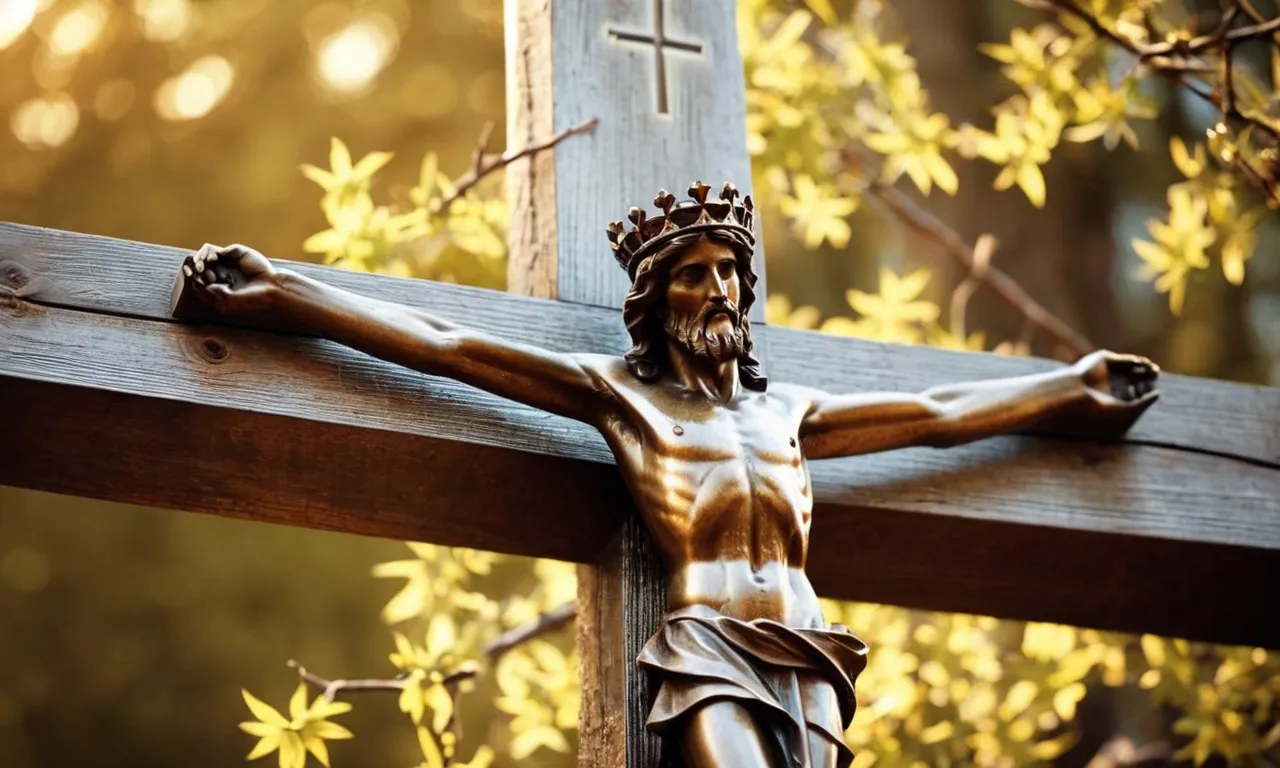What Did Jesus’ Cross Look Like? A Detailed Exploration
The cross of Jesus Christ stands as one of the most iconic symbols in all of Christianity. But what did the actual cross that Jesus was crucified on really look like? This is a question that has fascinated Christians throughout the ages.
If you’re short on time, here’s a quick answer to your question: Jesus’ cross was likely a large, T-shaped wooden beam without a crossbar. It would have been rough, heavy, and stained with blood.
In this comprehensive article, we will explore the various theories about the size, shape, and composition of Jesus’ cross.
Examining historical records, archeological evidence, and biblical context, we will reconstruct what Christ’s crucifixion apparatus potentially looked like nearly 2,000 years ago.
The Shape and Size of Jesus’ Cross
The Traditional Crucifix Shape
For centuries, the most common depiction of Jesus’ cross has been the Latin cross shape, with a longer vertical beam crossed by a shorter horizontal beam.
This shape is used in the crucifixes found in many churches and is instantly recognizable as a symbol of Christianity.
There is some historical evidence that supports the traditional crucifix shape. Roman writings refer to the stipes (vertical beam) and the patibulum (horizontal beam).
The victim would carry the patibulum to the execution site, where it would then be attached to the stipes that was permanently fixed in the ground.
This description matches the traditional crucifix shape.
Archaeological Evidence for a Single-Beam Shape
However, according to more recent archaeological findings, it is likely that Jesus’ cross was actually just one vertical beam inserted into the ground, with no separate crossbeam. This shape is sometimes called a crux simplex.
This strongly suggests that Jesus’ cross looked more like a vertical stake without a crossbeam.
The single-beam shape also makes practical sense from the Roman perspective. As carrying the entire cross would have been exceedingly difficult, the condemned person would likely have carried just the horizontal cross beam.
But a single beam avoids this need to join two pieces of wood at the execution site.
How Large was the Cross?
Early writings and artistic depictions differ quite a bit on the size of Jesus’ cross. Some suggest it was quite tall, perhaps as much as 15 to 20 feet. Others propose a shorter cross, no more than 6 to 9 feet high.
Most modern scholars conclude that Jesus’ cross was likely 9 to 12 feet tall. This size range matches typical Roman crosses used in antiquity.
A cross much larger than 12 feet would have been unnecessarily heavy and impractical to maneuver into an upright position.
The vertical beam likely measured between 7.5 and 9 feet above its insertion point in the ground. The horizontal beam (if used) would have been around 6 feet in length.
While still a substantial instrument of torture and execution, this size makes sense from an engineering perspective.
Regardless of its exact size and shape, Jesus’ cross serves as a powerful symbol of God’s love for humanity and Jesus’ sacrifice for our sins. The brutal instrument has been transformed into a message of redemption and hope for Christians worldwide.
The Composition and Appearance of the Wood
Made from Available Local Trees
Jesus’ cross would likely have been constructed from whatever timber was most readily available near Jerusalem at that time.
Historical records indicate that oak, cypress, and cedar trees were common in the region and were regularly used for Roman crucifixion crosses.
The vertical stake would have been sturdy and thick to bear the weight of a human body, approximately 9-12 feet tall.
A Rough, Unfinished Surface
The cross beams were roughly hewn planks with bark and knots still present on the wood surface.
As crucifixion was intended to not only execute but also humiliate the condemned, care would not have been taken to finely finish or smooth the wooden parts.
Splinters and jagged areas of bark helped to ensure the painful shredding of skin and flesh during the crucifixion process.
Stained with Blood During Crucifixion
As Jesus hung from the cross for six agonizing hours, blood flowing from the nails in his wrists and ankles as well as from the thorn crown pressed upon his head would have dripped down the wood.
Scriptural evidence and common crucifixion practice indicate whippings and beatings typically preceded the crucifixion itself, so blood from these wounds would have splattered onto the cross during its construction on site.
Evidence of the violence and agony endured by Jesus was literally soaked into the rough wooden beams.

The Original Location and Fate of the Cross
The Site of the Crucifixion
According to the Gospels, Jesus was crucified at Golgotha, also known as Calvary, outside the walls of Jerusalem (Matthew 27:33, Mark 15:22, Luke 23:33, John 19:17). The name “Golgotha” means “The Place of the Skull” in Aramaic.
The exact location of the site is uncertain, but the Church of the Holy Sepulchre in the Christian Quarter of Jerusalem’s Old City is the most agreed upon candidate.
This church was built in 335 AD under Constantine and allegedly encloses both Golgotha and Jesus’ empty tomb.
Another possible site, popular with Protestants, is Gordon’s Calvary near the Garden Tomb in Jerusalem, which got its name for its skull-like appearance. Ultimately, archeologists have not reached a consensus on the precise location of the crucifixion.
But the significance lies more in commemorating the sacrificial meaning of the cross rather than identifying the exact geographical spot.
What Happened to the Cross Afterward?
According to church tradition, Jesus’ cross was left at the site of the crucifixion after his death. In the early 4th century, Helena, the mother of Roman emperor Constantine, traveled to Jerusalem and allegedly discovered the cross buried beneath the temple of Venus built by Emperor Hadrian.
The spot was identified by a healing miracle when a sick man touched the cross. The rediscovered cross was then divided up, with parts sent to major cities like Constantinople and Rome.
Over the centuries, many churches have claimed to possess fragments of the True Cross. By the late Middle Ages, if all were added up, there were enough alleged pieces of the cross to build a ship!
Today most historians and archaeologists believe Helena’s cross to simply be a later religious relic.
The actual fate of the original cross is unknown, but it held deep theological meaning for early Christians as the instrument of salvation, pointing toward hope and redemption even through suffering.
Significance for Christianity Today
The True Cross vs. the Traditional Crucifix
The discovery of the True Cross by St. Helena in the 4th century was a momentous event for early Christianity.
After centuries of persecution under the Roman Empire, Christians could now venerate the actual wooden cross on which Jesus was crucified.
This tangible relic powerfully represented Christ’s sacrifice and God’s love for humanity. It inspired great fervor and devotion among believers.
In contrast, the traditional crucifix showing Christ’s body on the cross emerged later, around the 10th century. While also depicting Christ’s sacrifice, the crucifix emphasizes Christ’s suffering in a more visceral and graphic way.
The True Cross focuses more on the cross as a victorious symbol of salvation.
A Symbol of Christ’s Sacrifice
Today, the True Cross continues to remind Christians of Jesus’ death and resurrection. It represents God’s ultimate act of love and Christ’s willingness to suffer for the forgiveness of sins.
When Catholics and Orthodox Christians venerate the cross, they recall Christ’s amazing self-sacrifice on their behalf.
The traditional crucifix also represents Christ’s atoning sacrifice but in a more vivid, sobering manner. It portrays Christ’s agony and pain up close, provoking reflection on His suffering.
Both versions are powerful symbols that inspire awe at Christ paying the price for humanity’s redemption.
Some key differences:
- The empty True Cross focuses more on Christ’s resurrection and victory over death.
- The crucifix depicts Christ still on the cross, stressing His pain and suffering.
- The True Cross invokes triumph, while the crucifix often evokes mourning and sorrow.
- Protestants typically prefer the empty cross, while Catholics and Orthodox use both versions.
Regardless of the variation, the cross remains the central sign of Christian salvation hope. It represents Christ’s endless love and the promise of eternal life for those who believe.
Conclusion
The cross of Christ remains one of the most powerful and ubiquitous symbols of Christianity over 2,000 years after his death.
While we may never know its exact form with certainty, exploring what we do know about its likely size, shape, and composition helps us appreciate the reality of the sacrifice Jesus made.
The rough-hewn beams that bore the weight of the Savior’s broken body have given way to polished crucifixes adorning our churches and necks. Yet the message embodied in that original instrument of torture and death continues to inspire Christians worldwide.








